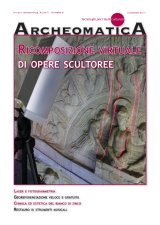GLI EFFETTI DI NATURA CHIMICA MECCANICA ED ESTETICA DELLE SUPERFICI DIPINTE CON PIGMENTI A OLIO A BASE DI BIANCO DI ZINCO
DOI:
https://doi.org/10.48258/arc.v2i4.88Parole chiave:
PIGMENTO, BIANCO DI ZINCO, CRITICITà€Abstract
L'ossido di zinco, conosciuto comunemente come bianco di zinco, nasce come pigmento quando in Francia fuutilizzato per la prima volta nel 1780. Il suo uso è stato ed è largamente diffuso, ma da sempre sono note alcune sue caratteristiche che potrebbero costituire un fattore di rischio per la superficie pittorica.
The effects of mechanical and aesthetic chemical nature of thepainted surfaces with pigment - Zinc oxide, commonly known aszinc white, born in France as a pigment when it was used for thefi rst time in 1780. Its use has been and is widely distributed, buthave always known that some characteristics may be a risk factorfor the painted surface.
Riferimenti bibliografici
G.Auer, W. D.r Griebler, J. Burkhardt, "White Pigments."
Industrial Inorganic Pigments, 2005 - 3rd Edition. p. 90.
M. F. Mecklenburg , C. S. Tumosa The chemical and mechanical effects of pigments on drying oils. Reviews in conservation number 6 2005
B. W. Singer, C. A. Liddie, A study of unusual degradation
on a seascape painting associated with the use of zinc white
pigment. The Paper Conservator, Volume 29 - 2006
Sullivan M. E., Zinc oxide: a study of its function in oil paintings and the consequences of its use", Conservation Analytical Laboratory Smithsonian Institution Washington, United States, 1994 BCIN Number: 175403
Elliot, S.B., The Alkaline Earth and Heavy Metal Soaps, New
York: Reinhold. 1946
Hamburgh, H.R. ,W. M. Morgans, ed. Hess's Paint Film Defects:
Their Casuses and Cure. 3rd ed. London: Chapman and
Hall, 1979.
Pappas, S. P. and R. M. Fischer. "Photochemistry of Pigments: Studies on the Mechanism of Chalking” Jornual of Paint
Tech, 46 N. 599 (1974): 65-72
Daniels V., "Discoloration of Paper Induced by Pigments
Containing Zinc” Restaurator 11, n.4, 1990
Morgans, W. M., Outlines of Paint Technology, vol. I, Materials.
New York: John Wiley & Sons. 1982
Sutherland K. R., Solvent extractable components of oil
paints fi lms, Amsterdam, FOM Institutes for Atomic and Molecular Physics 2001
##submission.downloads##
Pubblicato
Come citare
Fascicolo
Sezione
Licenza
Gli autori che pubblicano su questa rivista accettano le seguenti condizioni:- Gli autori mantengono i diritti sulla loro opera e cedono alla rivista il diritto di prima pubblicazione dell'opera, contemporaneamente licenziata sotto una Licenza Creative Commons - Attribuzione che permette ad altri di condividere l'opera indicando la paternità intellettuale e la prima pubblicazione su questa rivista.
- Gli autori possono aderire ad altri accordi di licenza non esclusiva per la distribuzione della versione dell'opera pubblicata (es. depositarla in un archivio istituzionale o pubblicarla in una monografia), a patto di indicare che la prima pubblicazione è avvenuta su questa rivista.
- Gli autori possono diffondere la loro opera online (es. in repository istituzionali o nel loro sito web) prima e durante il processo di submission, poiché può portare a scambi produttivi e aumentare le citazioni dell'opera pubblicata (Vedi The Effect of Open Access).





